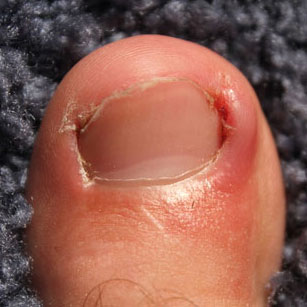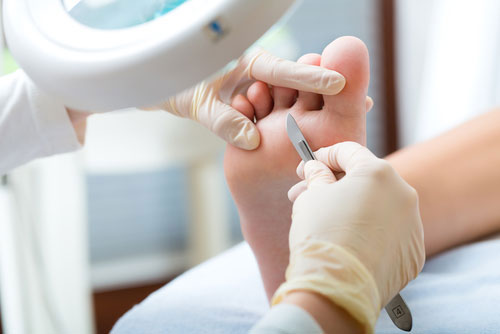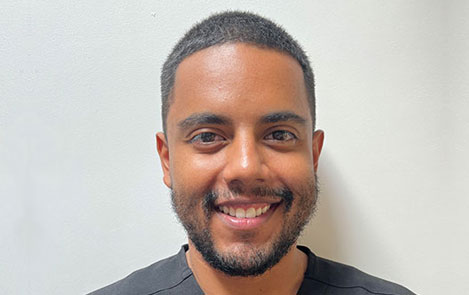Ingrown Toenails
An ingrown toenail (onychocryptosis) happens when a part of the nail grows into the skin, leading to inflammation, pain, and infection in the toe.

Some nails press into the skin without piercing the tissue, known as an involuted nail rather than an ingrown nail. This can also be painful, as a corn/callus is commonly found down the side of the nail as a reaction to the nail pressure.
What Causes an Ingrown Toenail?
Here are the main factors involved in the cause of ingrown toenails:
- The primary risk factor is the shape of the nail.
Some people have a first toenail that is more curved from side to side rather than being flat, making them more likely to become ingrown. The shape of our nails can be inherited but is also affected by pressure, either from the way we stand and walk, to the type of footwear we choose. - Poor nail cutting can influence how the remaining nail continues to grow.
Cutting toenails very short or at an angle down the side of the nail may result in the new nail growing in. Trimming too far down the sides or tearing rather than cutting nails is a common cause of an ingrown toenail. - Footwear with a narrow or shallow toe box is more likely to increase pressure between the skin in the nail fold and nail, increasing the risk of an ingrown nail.
- Previous trauma to the nail may alter the shape of the nail, making it more prone to becoming an ingrown nail.
- Ingrown toenails are often a symptom of an unstable foot.
Pressure at the front of the foot is often due to the back of the foot not being held in a level position to the ground and this may need to be looked into as part of the treatment. - Those with swollen feet or a ‘chubby’ or fleshy toe are more likely to have an ingrown nail.
- Excessive perspiration of the feet can often be a contributory factor, particularly if one or more of the above are also present. Those with sweaty feet may find the skin has less resistance to pressure and can be pierced more easily.
Home Care of Ingrown Toenails
To prevent ingrown toenails, it’s important to cut the nail straight across. This allows the corners to protrude, preventing them from penetrating the skin. If the nail is very curved on the sides, it can be difficult to do this on your own. In such cases, avoid cutting down the sides and seek professional help from Abbots Langley Foot Clinic.
Cutting a V into the end of the nail to treat an ingrown toenail is a myth. This will not cause the edge of the nail to grow together as the nail grows out. The shape of the nail is determined by the growing area at the base of the toe, not the end.
If you’re prone to ingrown toenails, avoid wearing shoes and socks that are too tight, and keep your feet clean to prevent infection. People with poor circulation or diabetes should not attempt self-management of ingrown toenails but should see a Podiatrist.
Treatment for Ingrown Toenails
Conservative treatment by a podiatrist may be required to prevent an ingrown nail from becoming a problem. Reshaping the nail and proper nail cutting can help it grow straight, away from the sides.
It is possible to painlessly remove the spike of an ingrown nail without using a local anesthetic, especially if it is only growing in at the tip of the toe. However, if the nail is ingrown towards the base, a local anesthetic is typically recommended to minimise patient distress during treatment.
Antibiotics are often necessary if the surrounding tissue is infected. However, the cause of the infection (the ingrown nail) still needs to be removed.
Surgical Treatment for Ingrown Toenails
If the ingrown nail is severe or does not respond to conservative care, minor surgical intervention is a good option. Minor surgery is a relatively simple procedure and is very successful in providing permanent relief.
The most common procedure is the removal of a section of the ingrown nail (Partial Nail Avulsion). This procedure not only leaves the nail pain-free but also in a cosmetically acceptable state since the majority of the nail remain intact.
In some cases where the nail is severely ingrown from both sides or is grossly thickened, it may be necessary to remove the entire nail (Total Nail Avulsion).
After a nail or part of the nail is removed, it will grow back as the growing cells at the base of the nail are still there. To prevent regrowth, an acid is usually used to destroy the growing cells and stop this painful condition from reoccurring.
After the surgery, you will need to keep your foot elevated for a few hours, and rest is advisable. The day after the surgery, you can return to work or school. It is advisable not to take part in vigorous activities, such as running, for 2 weeks after the surgery.
Call 01923 268787 to book an appointment
Clinic Information

Opening Hours
| Monday – Thursday: | 8:30 am – 6:00 pm |
| Friday: | 8:30 am – 5:30 pm |
| Saturday: | 8:30 am – 2:00 pm |


